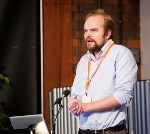| Dr Martyn Dade-Robertson (Newcastle University) |
| Thu 20 Apr 2017, 12:00 - 13:00 |
| C.H Waddington Building, Seminar room 1.08, King's Building's |
If you have a question about this talk, please contact: Julie Fyffe (jfyffe)

Architects have had a long-standing interest in Biology and, in more recent years this interest has extending to include speculation on a wide range of biotechnologies. One day, it is proposed, buildings may construct themselves be able to grow and heal using living materials and structures. My presentation will attempt to move beyond this speculation and introduce very early work we have been conducting using bacteria based technologies to create a new range of materials. As well as introducing a selection of our projects and concepts the presentation will focus on our EPSRC funded Computation Colloids project. This project investigates how Civil Engineering may be integrated with the emerging field of Synthetic Biology. Combining these fields has potentially transformative implications for both and may generate a new field of Engineering Design. Imagine a column of sand saturated with billions of engineered bacteria cells. As a force is applied to the top of the column, bacteria in the sand detect an increase in pressure. The bacteria respond by synthesising a new biological material to bind the grains together and resisting the load. The resulting structure would consist of a material where sand grains are only cemented where the forces through the material require. We are developing a proof of concept to show how we might design a manufacturing process where the material itself acts as manufacturer and designer, modelling and responding to its environment. Such a technology would push well beyond the current state of the art and challenge a new generation of engineering designers to think at multiple scales from molecular to the built environment and to anticipate civil engineering with living organisms.


